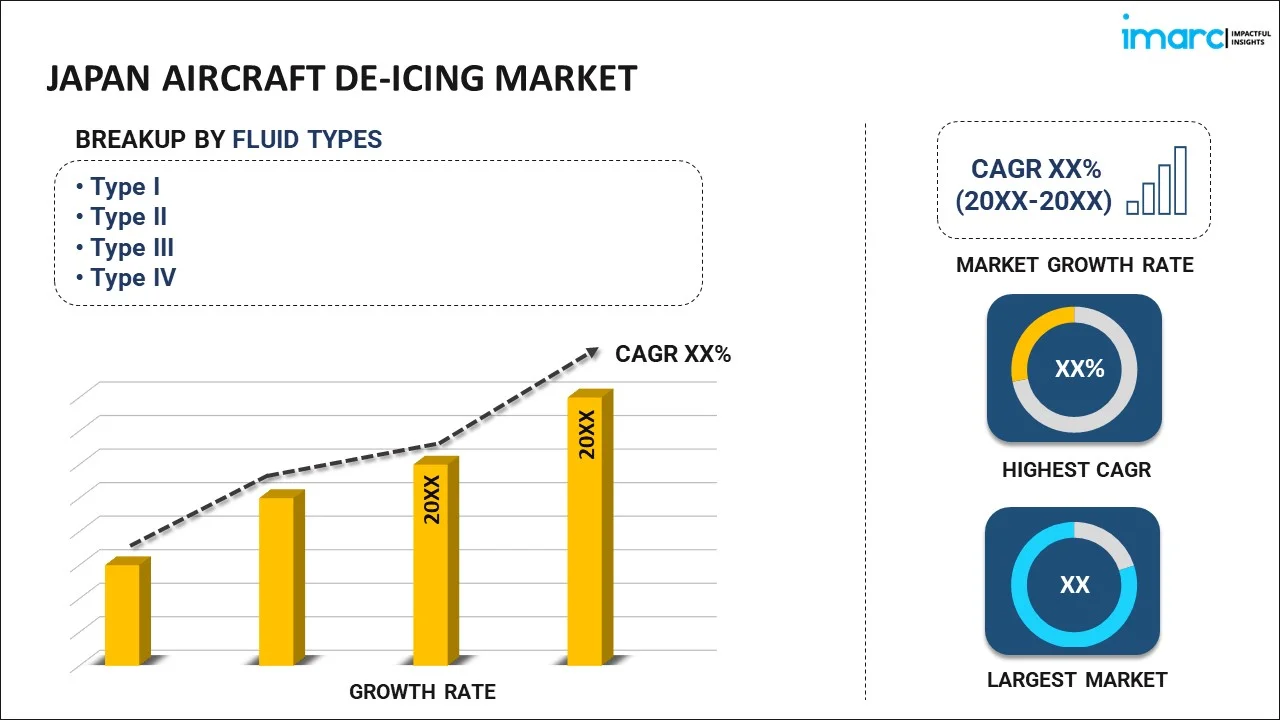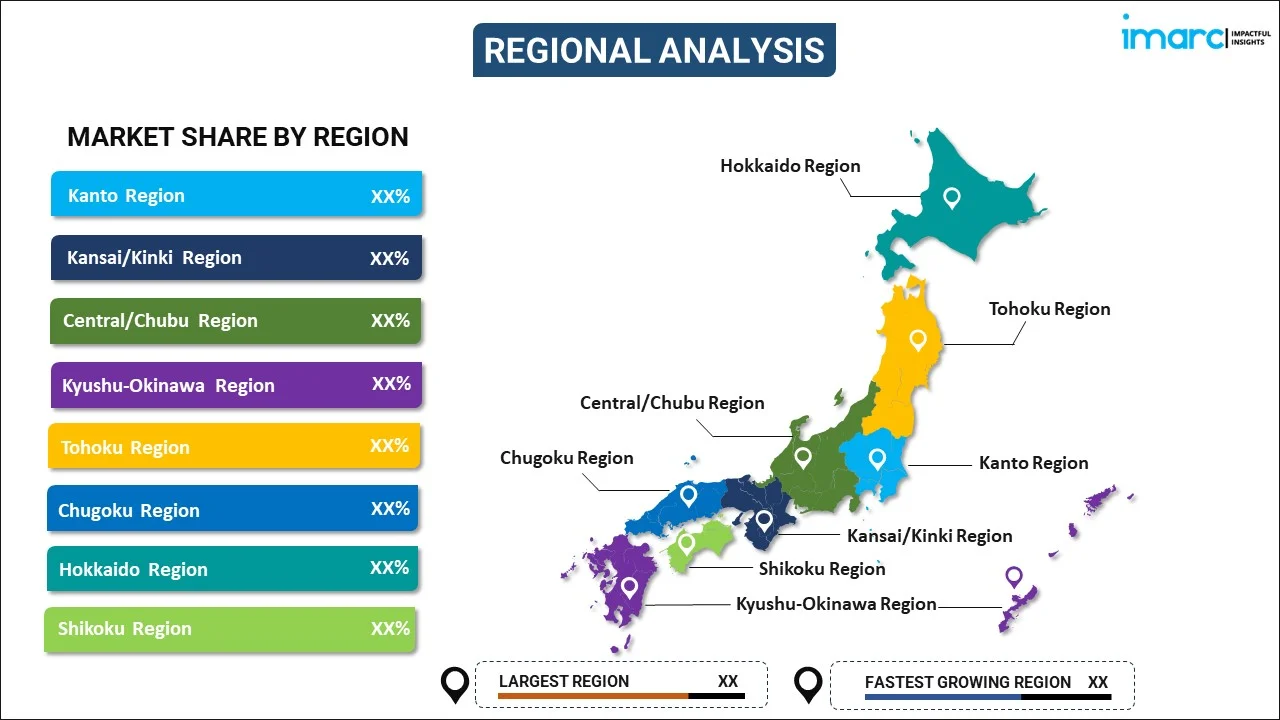
Japan Aircraft De-Icing Market Report by Fluid Type (Type I, Type II, Type III, Type IV), Application (Military, Commercial), Equipment (De-Icing Trucks, Sweepers, and Others), and Region 2025-2033
Market Overview:
Japan aircraft de-icing market size reached USD 80.0 Million in 2024. Looking forward, IMARC Group expects the market to reach USD 126.0 Million by 2033, exhibiting a growth rate (CAGR) of 5.1% during 2025-2033. The increasing advances in de-icing technologies, such as heated mats, anti-icing fluids, and electrothermal systems, which can improve the efficiency and effectiveness of de-icing processes, are primarily driving the market.
|
Report Attribute
|
Key Statistics
|
|---|---|
|
Base Year
|
2024
|
|
Forecast Years
|
2025-2033
|
|
Historical Years
|
2019-2024
|
|
Market Size in 2024
|
USD 80.0 Million |
|
Market Forecast in 2033
|
USD 126.0 Million |
| Market Growth Rate 2025-2033 | 5.1% |
Aircraft de-icing is a critical safety procedure employed in aviation to ensure the safe operation of aircraft during adverse weather conditions, particularly when ice, snow, or frost accumulates on the aircraft's surfaces. The process involves the removal of these frozen contaminants from various parts of the aircraft, such as wings, tail, engine inlets, and fuselage, to maintain aerodynamic efficiency and prevent performance degradation. De-icing typically utilizes specialized equipment and de-icing fluids, which are heated and applied to the aircraft's surfaces. These fluids melt and remove ice or snow while also providing a temporary protective coating to prevent further accumulation during takeoff and flight. In addition to ensuring proper lift and control, de-icing also enhances engine performance and prevents hazardous ice-related issues like ice-induced stall or control surface disruption. Aircraft de-icing is a critical step in aviation safety, as it helps prevent accidents caused by compromised flight performance due to icy conditions, ensuring passengers' and crew's safety during takeoff, flight, and landing in wintry weather. It is a meticulously regulated and essential aspect of modern aviation operations.
Japan Aircraft De-Icing Market Trends:
The aircraft de-icing market in Japan is witnessing robust growth owing to several interconnected factors. Firstly, the increasing frequency of adverse weather conditions, such as snow and ice storms, has amplified the demand for de-icing solutions. These harsh weather patterns necessitate the use of de-icing procedures to ensure safe takeoffs and landings. Secondly, the expansion of the aviation industry, both in terms of the number of flights and the size of the aircraft fleet, is a significant driver. As the aviation sector continues to soar, the need for efficient and reliable de-icing systems becomes paramount to prevent costly delays and ensure passenger safety. Furthermore, stringent safety regulations imposed by aviation authorities in Japan are pushing airlines and operators to invest in state-of-the-art de-icing technologies. Compliance with these regulations is non-negotiable, propelling the market's growth. Additionally, the emergence of advanced de-icing materials and innovative techniques, which offer improved efficiency and environmental sustainability, aligning with the growing focus on eco-friendly aviation practices, is expected to drive the regional aircraft de-icing market in the coming years.
Japan Aircraft De-icing Market Segmentation:
IMARC Group provides an analysis of the key trends in each segment of the market, along with forecasts at the country level for 2025-2033. Our report has categorized the market based on fluid type, application, and equipment.
Fluid Type Insights:

- Type I
- Type II
- Type III
- Type IV
The report has provided a detailed breakup and analysis of the market based on the fluid type. This includes type i, type ii, type iii, and type iv.
Application Insights:
- Military
- Commercial
A detailed breakup and analysis of the market based on the application have also been provided in the report. This includes military and commercial.
Equipment Insights:
- De-Icing Trucks
- Sweepers
- Others
The report has provided a detailed breakup and analysis of the market based on the equipment. This includes de-icing trucks, sweepers, and others.
Regional Insights:

- Kanto Region
- Kansai/Kinki Region
- Central/ Chubu Region
- Kyushu-Okinawa Region
- Tohoku Region
- Chugoku Region
- Hokkaido Region
- Shikoku Region
The report has also provided a comprehensive analysis of all the major regional markets, which include Kanto Region, Kansai/Kinki Region, Central/ Chubu Region, Kyushu-Okinawa Region, Tohoku Region, Chugoku Region, Hokkaido Region, and Shikoku Region.
Competitive Landscape:
The market research report has also provided a comprehensive analysis of the competitive landscape. Competitive analysis such as market structure, key player positioning, top winning strategies, competitive dashboard, and company evaluation quadrant has been covered in the report. Also, detailed profiles of all major companies have been provided.
Japan Aircraft De-icing Market Report Coverage:
| Report Features | Details |
|---|---|
| Base Year of the Analysis | 2024 |
| Historical Period | 2019-2024 |
| Forecast Period | 2025-2033 |
| Units | Million USD |
| Scope of the Report | Exploration of Historical Trends and Market Outlook, Industry Catalysts and Challenges, Segment-Wise Historical and Future Market Assessment:
|
| Fluid Types Covered | Type I, Type II, Type III, Type IV |
| Applications Covered | Military, Commercial |
| Equipments Covered | De-Icing Trucks, Sweepers, Others |
| Regions Covered | Kanto Region, Kansai/Kinki Region, Central/ Chubu Region, Kyushu-Okinawa Region, Tohoku Region, Chugoku Region, Hokkaido Region, Shikoku Region |
| Customization Scope | 10% Free Customization |
| Post-Sale Analyst Support | 10-12 Weeks |
| Delivery Format | PDF and Excel through Email (We can also provide the editable version of the report in PPT/Word format on special request) |
Key Questions Answered in This Report:
- How has the Japan aircraft de-icing market performed so far and how will it perform in the coming years?
- What has been the impact of COVID-19 on the Japan aircraft de-icing market?
- What is the breakup of the Japan aircraft de-icing market on the basis of fluid type?
- What is the breakup of the Japan aircraft de-icing market on the basis of application?
- What is the breakup of the Japan aircraft de-icing market on the basis of equipment?
- What are the various stages in the value chain of the Japan aircraft de-icing market?
- What are the key driving factors and challenges in the Japan aircraft de-icing?
- What is the structure of the Japan aircraft de-icing market and who are the key players?
- What is the degree of competition in the Japan aircraft de-icing market?
Key Benefits for Stakeholders:
- IMARC’s industry report offers a comprehensive quantitative analysis of various market segments, historical and current market trends, market forecasts, and dynamics of the Japan aircraft de-icing market from 2019-2033.
- The research report provides the latest information on the market drivers, challenges, and opportunities in the Japan aircraft de-icing market.
- Porter's five forces analysis assist stakeholders in assessing the impact of new entrants, competitive rivalry, supplier power, buyer power, and the threat of substitution. It helps stakeholders to analyze the level of competition within the Japan aircraft de-icing industry and its attractiveness.
- Competitive landscape allows stakeholders to understand their competitive environment and provides an insight into the current positions of key players in the market.
Need more help?
- Speak to our experienced analysts for insights on the current market scenarios.
- Include additional segments and countries to customize the report as per your requirement.
- Gain an unparalleled competitive advantage in your domain by understanding how to utilize the report and positively impacting your operations and revenue.
- For further assistance, please connect with our analysts.
 Inquire Before Buying
Inquire Before Buying
 Speak to an Analyst
Speak to an Analyst
 Request Brochure
Request Brochure
 Request Customization
Request Customization




.webp)




.webp)












